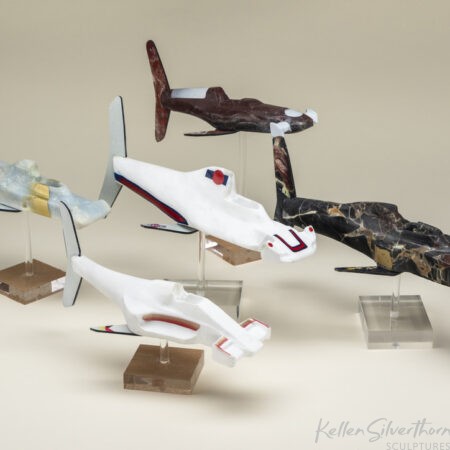Hammerheads – inspired by F1 grid of early 1970s
The F1 grid of the first years of the 1970s hosted a slew of gifted drivers Rindt, Ickx, Stewart, Fittipaldi, Lauda, Hunt, Petersen, Scheckter, Andretti, Amon, Brabham, Hulme, Surtees, Siffert, and many more. Cosworth V8 power battled a legion of V12 contenders, not just Ferrari’s. Small teams might have as few as 8 members, rather than the many hundreds of today. Race, and season, results back then were far more unpredictable than in recent decades.

Photo Credit the bleacher report. High Speed duel at Monza
Sculpting F1 cars weren’t the first projects I thought about as I settled into my artistic niche. Yet, the shark nose Ferrari 156 of 1961 had always held my aesthetic attention, precisely because of that predator nose. I was eventually able to make that F1 model the subject of my experimental aquarium-intended work Shark Tank 156.
During the many silent hours of that project, it occurred to me that there were other F1 cars that looked shark-like if you squinted just right. In particular, the front splitters of the early wing era, when combined with slightly later in-period tall air boxes, looked a lot like Hammerhead sharks.
I mentally filed the Hammerhead idea away. Eventually, as filed ideas often do, it kept coming back into consciousness. Artists are wedded to their series. So, I didn’t put up a lot of resistance to another in the F1 series. Rather, I thought about how best to showcasing a variety of color schemes, car shapes, and famous F1 constructors of the era. As well, I debated what sculpture features would be of a F1 car, and what would be from the world of sharks.
This Hammerhead F1 installation is again aquarium-intended. I felt a few more visual cues beyond the partial shape and base color would help lead the enthusiast viewer to mentally reach my intended destination. So, I had my Graphic artist friend Mick come up with a few complimentary color additions. The only requirement was that each addition had to be within the possible realm of Hammerhead colorations in a parallel universe.
If the installation’s viewer came up with the John Player Lotus 72, Yardley McLaren M23, Ferrari 312B, Martini & Rossi Brabham BT44, and Elf Tyrrell 006 then I’ve succeeded. (And you know your F1 history).
Ferrari 312B. Designed by Mauro Forghieri, the flat-12 powered 312B was the tifosi torchbearer for five seasons, 1970 through 1974. The car’s clean lines were its most iconic 1970-72. The Scuderia’s best Team finishes were as runner-up in both 1970 and 1974, while Jackie Ickx was best placed in the Driver’s standings at 2nd in 1970….. a feat repeated by Clay Regazzoni in the 312B3 of 1974.

Full-face helmets were still in the future. Ferrari 312B. Photo Credit oldracingcars.com
Lotus 72. The Lotus 72 spanned the same five seasons, 1970-74. Where the Ferrari 312B’s appearance was rather traditional, the Lotus 72 was cutting edge. It almost looks alien in 1970-72 grid photographs. Maurice Philippe’s ground-breaking Lotus design sported a wedge nose, side-mounted radiators, a magnesium monocoque, and torsion bar suspension. The design delivered Lotus its fourth (1970), fifth (1972), and sixth (1973) Team Championships, drawing them equal to Ferrari’s then-retrospective tally. Driver’s championships in the Lotus 72 were earned by Jochen Rindt (1970, posthumously), and Emmerson Fittipaldi 1972, with Fittipaldi / Petersen finishing 2nd and 3rd in 1973 respectively.

JPS liveried Lotus 72 at speed. Photo Credit snaplap.net
McLaren M23: The Gordon Coppuck design debuted in 1973, parroting much of the Lotus 72 design, but to be fair, more influenced by the McLaren M16 Indy car. The model served as the McLaren war horse for four seasons,1973-76. It delivered McLaren’s first-ever driver’s champions (Fittipaldi 1974, and Hunt 1976), and first-ever Constructor’s championship in 1974.

Photo Credit racingsportscars.com Yardley McLaren M23 at the ‘Ring
Tyrrell 006 design by Derek Gardner, also debuted in 1973. To me the 006 embodies the Jackie Stewart era Tyrrells. Stewart retired after winning his third driver’s championship (1969, 1971, 1973), all with Tyrrell. The Team clinched the Constructor’s world title in 1971, and was runner-up in 1972 and 1973. With Ford paying most of the bills, the livery of that era is rather mundane, so I’ve also borrowed inspiration from the more memorable livery of iconic P34 Tyrrell of 1976.

Jackie Stewart in the all-conquering Tyrrell 006
Brabham’s BT44, by the celebrated Gordon Murray, was the last of our five-some to debut (1974). Essentially, it was an evolved BT42 (debut 1973). The updated car graced the grid until replaced by the rosso-liveried flat-12 BT45 Brabham-Alfa of 1976. The graceful BT44’s best Team finish was 2nd in the 1975 Championship, with the best placed driver on the season, also from 1975 (3rd, Carlos Reutemann).

Brabham BT44, late in the lap at Nurburgring. Photo credit twitter.com
Canadian fans may be surprised to learn that their countryman Eppie Wietzes raced a third Brabham in the 1974 Canadian GP, (as I was when Eppie shared the tale with me over the weeklong Targa Newfoundland of 2008….while we watched on SpeedVision Sebastian Vettel’s shock debut F1 win at Monza for Toro Rosso).

The Brabham entered for Eppie Wietze’s at Canadian GT Photo Credit racedepartment.com
THE STONE
I generally keep a stock of Laguna Rosso (Ferrari) and Statuario (Brabham + McLaren) around, so off-cuts were not difficult to come up with. I’ve used a limited amount of the blue Alabaster before, so thanks to Stone’Eng (Patrick) for contributing that piece to the project. This particular Portoro is a new varietal to me, again contributed by Stone’Eng.
Aquariums don’t tolerate metal, so again Plexiglas was employed for the stands.






